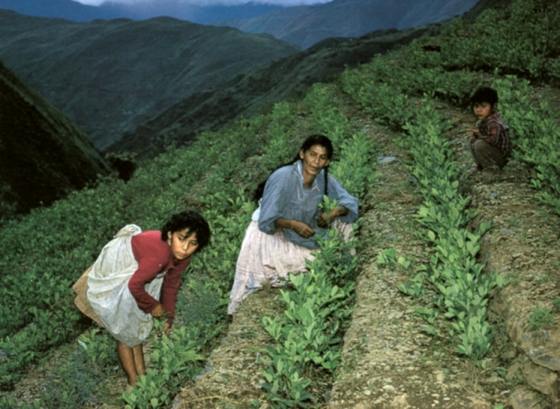 (Picture credit raintree.com)
(Picture credit raintree.com)A new UN report has shown a marked increase in coca cultivation in the Andes region of Bolivia, Colombia and Peru. Colombia showed the largest increase in 2007 with a 27 percent rise in the total land under cultivation while the other two countries showed single-digit percentage increases. Despite the increases the total output of coca products remained unchanged last year due to low yields. The region produces 60 per cent of the entire world’s cocaine output with a farm gate value of $1.4 billion in 2007. This is not just a local problem. 88 per cent of all the region’s products ends up in the US via Mexico.
The report was compiled by the UN Office of Drugs and Crime (UNODC). Called “Cocoa cultivation in the Andes region” (pdf), it is a study of the drug trade in Bolivia, Colombia and Peru. Colombia has been the world’s largest producer of cocaine since the 1980s and illicit coca cultivation has expanded steadily since then particularly in remote areas of the Amazon Basin. The farmers either sell the coca leaves, or process them into coca paste or base. The last step is the processing of the cocaine base into cocaine hydrochloride which is not carried out in clandestine laboratories.
The report is the work of UNODC’s Illicit Crop Monitoring Programme (ICMP) which was set up to promote the development of a global network of illicit crop monitoring systems. ICMP is currently active in seven countries: Afghanistan, Bolivia, Colombia, Laos, Morocco, Burma and Peru. Until 2006, the coca cultivation areas were monitored by satellite imagery, but in 2007 the methodology was enhanced by the use of very high resolution photos from airplanes.
The findings have raised serious questions about the efficacy of Colombia’s US-backed “war on drugs” campaign. UNODC’s executive director Antonio Maria Costa says the increase is a surprise and a shock. He said it was a surprise because the Colombian government is trying so hard to eradicate coca and a shock because of the magnitude of cultivation. Costa said most coca is grown in areas controlled by insurgents and he compared the situation with Afghanistan’s opium crop where “most opium is grown in provinces with a heavy Taliban presence.” Costa said the best hope for eradication would be the disarray of the Colombian rebel group Revolutionary Armed Forces of Colombia (FARC).
Despite the obvious failure of the existing program, the US has pledged its continued support. The US State Department said it to continue to “work with President Uribe and his government, as well as others in the region, to continue this effort”. America has backed a multi-billion dollar eradication program but its efficiency has been questioned in recent times. Colombia UNODC representative Aldo Lale-Demoz says farmers plant elsewhere in the wake of each eradication program. “They go further afield from their homes,” he said. “They will not tend those plots as well as they did before, so the productivity of those secondary lots is much lower."
 In other early reaction, Colombia’s chief of police dismissed the report’s conclusion that Colombia was the world’s cocaine hub. Oscar Naranjo expressed “great surprise and a series of concerns” over the measurement techniques used by the report. He claimed the UN measurement system is based on information from a French satellite that stopped detecting the scale of illegal crops years ago. Earlier last week, the Colombian authorities said that the country has eradicated 31,000 hectares of coca crops since January, surpassing the amount eradicated in the same period of 2007. This still leaves 70,000 hectares under cultivation if the report is correct and does not take into account any new cultivation. This would appear to be Naranjo’s real “series of concerns”.
In other early reaction, Colombia’s chief of police dismissed the report’s conclusion that Colombia was the world’s cocaine hub. Oscar Naranjo expressed “great surprise and a series of concerns” over the measurement techniques used by the report. He claimed the UN measurement system is based on information from a French satellite that stopped detecting the scale of illegal crops years ago. Earlier last week, the Colombian authorities said that the country has eradicated 31,000 hectares of coca crops since January, surpassing the amount eradicated in the same period of 2007. This still leaves 70,000 hectares under cultivation if the report is correct and does not take into account any new cultivation. This would appear to be Naranjo’s real “series of concerns”.


